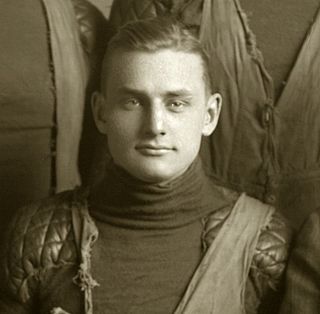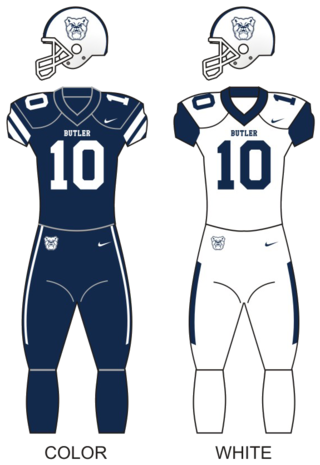Related Research Articles

Butler University is a private university in Indianapolis, Indiana. Founded in 1855 and named after founder Ovid Butler, the university has over 60 major academic fields of study in six colleges: the Lacy School of Business, College of Communication, College of Education, College of Liberal Arts and Sciences, College of Pharmacy and Health Sciences, and Jordan College of the Arts. Its 295-acre (119 ha) campus is approximately five miles (8.0 km) from downtown Indianapolis.

Hinkle Fieldhouse is a basketball arena on the campus of Butler University in Indianapolis, Indiana. Completed in early 1928, it was the largest basketball arena in the United States until 1950. The facility was renamed Hinkle Fieldhouse in 1966 in honor of Butler's longtime coach and athletic director, Paul D. "Tony" Hinkle. It is the sixth-oldest college basketball arena still in use. Added to the National Register of Historic Places in 1983 and designated a U.S. National Historic Landmark in 1987, Hinkle Fieldhouse is sometimes referred to as "Indiana's Basketball Cathedral."

David Way Allerdice was an American football player and coach. He played college football as the University of Michigan as a halfback from 1907 to 1909. Allerdice served as the head football coach at Butler University in 1911 and the University of Texas at Austin from 1911 to 1915. He left Butler after the team's first game in early October to move to Texas, succeeding his former Michigan teammate Billy Wasmund, who had died from a fall.
Edwin R. Taber was an American college football coach. He was the first head football coach at Wabash College in Crawfordsville, Indiana, serving for one season, in 1884 season, and compiling a record of 1–0.

The Butler Bulldogs football program is the intercollegiate American football team for Butler University located in the U.S. state of Indiana. The team competes in the NCAA Division I Football Championship Subdivision (FCS) and are members of the Pioneer Football League. Butler's first football team was fielded in 1887. The team plays its home games at the 7,500 seat Bud and Jackie Sellick Bowl in Indianapolis. The Bulldogs are coached by Mike Uremovich.
The Wabash Little Giants football team represents Wabash College in the sport of college football at the NCAA Division III level. The Little Giants have competed as a member of the North Coast Athletic Conference (NCAC) since 2000. Wabash plays home games at Hollett Little Giant Stadium in Crawfordsville, Indiana. Don Morel has served as the team's head coach since 2016.

The 1889 Purdue football team was an American football team that represented Purdue University as an independent during the 1889 college football season. The team compiled a 2–1 record in the university's second season fielding an intercollegiate football team. Archaeologist and Harvard alumnus, George Andrew Reisner, was the team's coach. The team opened its season on November 16 with a 34–10 victory over DePauw for the first victory in Purdue football history and the first game played in Lafayette, Indiana. Purdue defeated Wabash the following week, 18–4, and concluded its season on November 29 with a 14–0 loss against Butler. J. M. Sholl was the team captain.
The 1895 Indiana Hoosiers football team was an American football team that represented Indiana University Bloomington during the 1895 college football season. Prior to 1895, Indiana had fielded a football team in seven seasons and had yet to win an intercollegiate football game. For the 1895 season, Indiana hired former Harvard quarterback and national tennis champion Robert Wrenn to coach its football team. Under Wrenn's leadership, the Indiana football team compiled a 4–3–1 record, including the university's first intercollegiate football victories, over Rose Polytechnic (8–4) and Wabash (12–10).
The 1884 DePauw football team represented DePauw University during the 1884 college football season. The team lost the first game played in the state of Indiana to Butler by a score of 4–0.
The 1893 Butler Christians football team represented Butler University during the 1893 college football season. The team compiled a record of 4–2. Alfred H. Somerville was the team captain. The team began the season with 23 players.
The 1948 Western Reserve Red Cats football team represented the Western Reserve University in the American city of Cleveland, Ohio, now known as Case Western Reserve University, during the 1948 college football season. The Red Cats were a member of the Mid-American Conference (MAC).
The 1941 Butler Bulldogs football team was an American football team that represented Butler University as a member of the Indiana Intercollegiate Conference (IIC) during the 1941 college football season. In its third season under head coach Tony Hinkle, the team compiled a 5–4 record. The team played its home games at the Butler Bowl in Indianapolis.
The 1948 Cincinnati Bearcats football team was an American football team that represented the University of Cincinnati as a member of the Mid-American Conference (MAC) during the 1948 college football season. The Bearcats were led by head coach Ray Nolting and compiled a 3–6–1 record.
The 1955 Ball State Cardinals football team was an American football team that represented Ball State Teachers College in the Indiana Collegiate Conference (ICC) during the 1955 college football season. In their third and final season under head coach George Serdula, the Cardinals compiled a 3–5 record, tied for last place out of seven teams in the ICC, and were outscored by a total of 144 to 97.
The 1951 Ball State Cardinals football team was an American football team that represented Ball State Teachers College in the Indiana Collegiate Conference (ICC) during the 1951 college football season. In its 16th season under head coach John Magnabosco, the team compiled a 0–6–1 record and finished in last place in the ICC.
The 1951 Butler Bulldogs football team was an American football team that represented Butler University as a member of the Indiana Collegiate Conference (ICC) during the 1951 college football season. Led by 14th-year head coach Tony Hinkle, the Bulldogs compiled an overall record of 4–4–1 with a mark of 3–2 in conference play, placing third in the ICC.
The 1946 Indiana Inercollegiate Conference football season was the season of college football played by the 15 member schools of the Indiana Intercollegiate Conference (IIC) as part of the 1946 college football season.
The 1905 Butler Christians football team represented Butler University as an independent during the 1905 college football season. Led by Edgar Wingard in his second and final season as head coach, the Christians compiled a record of 7–2–1.
The Wabash football program from 1884 to 1899 represented Wabash College in its first decade of college football competition. The team did not take on the nickname "Little Giants" until late in the 1904 season. Wabash did not play intercollegiate games in 1885 or 1888.
The DePauw football program from 1884 to 1899 represented DePauw University in its first decade of college football competition. The team did not take on the nickname "Tigers" until 1918 Wabash did not play any intercollegiate games between 1885 and 1888.
References
- ↑ "Foot Ball". Indianapolis Journal . Indianapolis, Indiana. May 30, 1884. p. 8. Retrieved June 30, 2024– via Newspapers.com
 .
. - ↑ "The Little Giants". College Football Historical Society Newsletter. 19 (4): 5–6. 2006. Retrieved June 29, 2024– via LA84 Foundation.